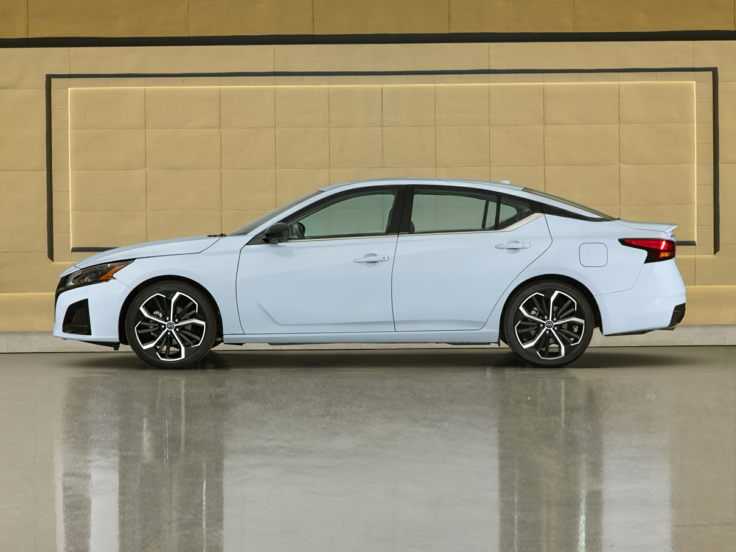Nissan ALTIMA 2023 Maintenance Precautions and Battery
In addition to a battery that is key to the 2023 Nissan Altima’s performance and dependability, the car also has a number of other important maintenance features. To maintain maximum operating efficiency and warranty coverage, routine maintenance precautions include using original Nissan parts, according to the suggested service plan, and trusting repairs to qualified technicians. The battery, which usually lasts three to five years, it is essential to the Altima’s electrical system. By utilizing battery maintainers when not in use, owners can assist in extending its life. Professional inspections or routine checks with a battery tester can also help guarantee that it stays in good condition. Together, these measures preserve the Altima’s longevity and guarantee dependable performance and peace of mind on every trip.
2023 Nissan Altima Specs, Price, Features, and Mileage (Brochure)
MAINTENANCE PRECAUTIONS
When performing any inspection or maintenance work on your vehicle, always take care to prevent serious accidental injury to yourself or damage to the vehicle. The following are general precautions that should be closely observed.
WARNING
Park the vehicle on a level surface, apply the parking brake securely, and block the wheels to prevent the vehicle from moving. Move the shift lever to P (Park). Be sure the ignition switch is in the OFF or LOCK position when performing any parts replacement or repairs. If you must work with the engine running, keep your hands, clothing, hair, and tools away from moving fans, belts, and any other moving parts. It is advisable to secure or remove any loose clothing and any jewelry, such as rings, watches, etc. before working on your vehicle. Always wear eye protection whenever you work on your vehicle. Your vehicle is equipped with an automatic engine cooling fan. It may come on at any time without warning, even if the ignition switch is in the OFF position and the engine is not running. To avoid injury, always disconnect the negative battery cable before working near the fan. If you must run the engine in an enclosed space such as a garage, be sure there is proper ventilation for exhaust gases to escape. Never get under the vehicle while it is supported only by a jack. If it is necessary to work under the vehicle, support it with safety stands. Keep smoking materials, flame, and sparks away from the fuel tank and battery. On gasoline engine models, the fuel filter or fuel lines should be serviced. It is recommended that you visit a NISSAN dealer for this service because the fuel lines are under high pressure even when the engine is off.
CAUTION
Do not work under the hood while the engine is hot. Turn the engine off and wait until it cools down. Avoid contact with used engine oil and coolant. Improperly disposed of engine oil, engine coolant, and/or other vehicle fluids can damage the environment. Always conform to local regulations for the disposal of vehicle fluid. Never leave the engine or the trans-mission-related component harness connector disconnected while the ignition switch is in the ON position. Never connect or disconnect the battery or any transistorized component while the ignition switch is in the ON position. This “Do-it-yourself” section gives instructions regarding only those items which are relatively easy for an owner to perform. A Genuine NISSAN service manual is also available.
You should be aware that incomplete or improper servicing may result in operating difficulties or excessive emissions, and could affect warranty coverage. If in doubt about any servicing, it is recommended that you have it done by a NISSAN dealer.
ENGINE COMPARTMENT CHECK LOCATIONS

2.0L 4 cylinder (KR20DDET engine model)
- Engine coolant reservoir
- Drive belt location
- Engine oil filler cap
- Brake fluid reservoir
- Battery
- Fuse/Fusible link box
- Air cleaner
- Radiator cap
- Engine oil dipstick
- Windshield-washer fluid reservoir
NOTE:
Your vehicle may not be equipped with an engine cover.
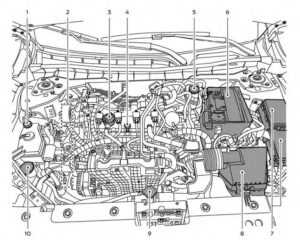
2.5L 4 cylinder (PR25DD engine model)
- Engine coolant reservoir
- Drive belt location
- Engine oil filler cap
- Engine oil dipstick
- Brake fluid reservoir
- Battery
- Fuse/Fusible link box
- Air cleaner
- Radiator cap
- Windshield-washer fluid reservoir
NOTE:
Your vehicle may not be equipped with an engine cover.
ENGINE COOLING SYSTEM
The engine cooling system is filled at the factory with a pre-diluted mixture of 50%Genuine NISSAN Long Life Antifreeze/Coolant (blue) and 50% water to provide year-round antifreeze and coolant protection. The antifreeze solution contains rust and corrosion inhibitors. Additional engine cooling system additives are not necessary.
WARNING
Never remove the radiator or coolant reservoir cap when the engine is hot. Wait until the engine and radiator cool down. Serious burns could be caused by high-pressure fluid escaping from the radiator. The radiator is equipped with a pressure-type radiator cap. To prevent engine damage, use only a Genuine NISSAN radiator cap.
CAUTION
Never use any cooling system additives such as radiator sealer. Additives may clog the cooling system and cause damage to the engine, transmission, and/or cooling system. When adding or replacing coolant, be sure to use only Genuine NISSAN Long Life Antifreeze/Coolant (blue) or equivalent. Genuine NISSAN Long Life Antifreeze/Coolant (blue) is pre-diluted to provide antifreeze protection to -34° F (-37° C). If additional freeze protection is needed due to weather where you operate your vehicle, add Genuine NISSAN Long Life Antifreeze/Coolant (blue) concentrate following the directions on the container. If an equivalent coolant other than Genuine NISSAN Long Life Antifreeze/Coolant (blue) is used, follow the coolant manufacturer’s instructions to maintain minimum antifreeze protection to -34° F (-37° C). The use of other types of coolant solutions other than Genuine NISSAN Long Life Antifreeze/Coolant (blue) or equivalent may damage the engine cooling system. The life expectancy of the factory-fill coolant is 105,000 miles (168,000 km) or 7 years. Mixing any type of coolant other than Genuine NISSAN Long Life Antifreeze/Coolant (blue)(or equivalent coolant), including Genuine NISSAN Long Life Antifreeze/Coolant (green), or the use of non-distilled water may reduce the life expectancy of the factory-fill coolant. For additional information, see the “Maintenance and schedules” section of this manual.
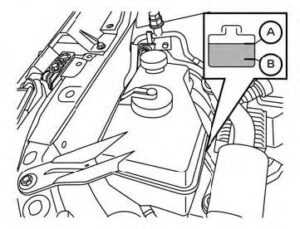
CHECKING ENGINE COOLANT LEVEL
COOLANT LEVEL
Check the coolant level in the reservoir when the engine is cold. If the coolant level is below the MIN level OB, add coolant to the MAX level OA. If the reservoir is empty, check the coolant level in the radiator when the engine is cold. If there is insufficient coolant in the radiator, fill the radiator with coolant up to the filler opening and add it to the reservoir up to the MAX level OA. Start the engine and allow the engine coolant temperature gauge to rise until it reaches normal operating temperature. Turn off the engine once the engine coolant temperature has reached normal operating range. Allow the engine coolant to cool to ambient temperature. Recheck the coolant level in the reservoir and add coolant to the MAX level if necessary. This vehicle contains Genuine NISSAN Long Life Antifreeze/Coolant (blue). The life expectancy of the factory-fill coolant is 105,000 miles (168,000 km) or 7 years. Mixing any other type of coolant or the use of non-distilled water will reduce the life expectancy of the factory-fill coolant. For additional information, see the “Maintenance and schedules” section of this manual. If the cooling system frequently requires coolant, have it checked. It is recommended that you visit a NISSAN dealer for this service.
CHANGING ENGINE COOLANT
A NISSAN dealer can change the engine coolant. The service procedure can be found in the NISSAN Service Manual. Improper servicing can result in reduced heater performance and engine overheating.
WARNING
- To avoid the danger of being scalded, never change the coolant when the engine is hot.
- Never remove the radiator cap when the engine is hot. Serious burns could be caused by high-pressure fluid escaping from the radiator.
- Avoid direct skin contact with used coolant. If skin contact is made, wash thoroughly with soap or hand cleaner as soon as possible.
- Keep coolant out of the reach of children and pets.
- Engine coolant must be disposed of properly. Check your local regulations.
ENGINE OIL
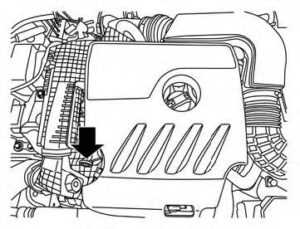
2.0L 4 cylinder (KR20DDET engine model)
CHECKING ENGINE OIL LEVEL
- Park the vehicle on a level surface and apply the parking brake.
- Start the engine and let it idle until it reaches operating temperature.
- Turn off the engine. Wait more than 10 minutes for the oil to drain back into the oil pan.
- Remove the dipstick and wipe it clean. Reinsert it all the way.

2.5L 4 cylinder (PR25DD engine model) - Remove the dipstick again and check the oil level. It should be between the H (High) and L (Low) marks OB. This is the normal operating oil level range. If the oil level is below the L (Low) mark OA, remove the oil filler cap and pour the recommended oil through the opening. Do not fill oil level above H (High) mark OC.
- Recheck the oil level with the dipstick.
- It is normal to add some oil between oil maintenance intervals or during the break-in period, depending on the severity of operating conditions.
CAUTION
Oil levels should be checked regularly. Operating the engine with an insufficient amount of oil can damage the engine, and such damage is not covered by warranty. It is normal to add some oil between oil maintenance intervals or during the break-in period, depending on the severity of operating conditions.
CHANGING ENGINE OIL AND OIL FILTER
For additional information on engine oil and oil filter change, refer to the instructions outlined in this section.
Vehicle set-up
- Park the vehicle on a level surface and apply the parking brake.
- Run the engine until it reaches operating temperature.
- Turn the engine off and wait for 15 minutes.
- Raise and support the vehicle using a suitable floor jack and safety jack stands.
- Place the safety jack stands under the vehicle jack-up points. A suitable adapter should be attached to the jack stand saddle.
CAUTION
Make sure the correct lifting and support points are used to avoid vehicle damage.


2O Oil drain plug (2.0L 4 cylinder (KR20DDET engine model))
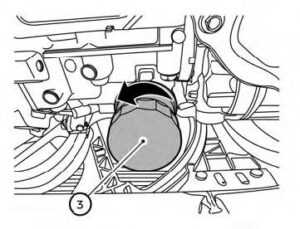
2O Oil drain plug (2.5L 4 cylinder (PR25DD engine model)) 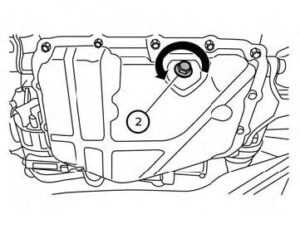

3O Oil filter (2.0L 4 cylinder (KR20DDET engine model))
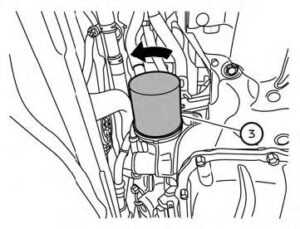
3O Oil filter (2.5L 4 cylinder (PR25DD engine model)) 
4O Undercover 
Removal of undercover
Remove fasteners OA and undercover.
Engine oil and filter
- Place a large drain pan under the drain plug and oil filter.
- Remove the oil filler cap.
- Remove the drain plug with a wrench by turning it counterclockwise and completely drain the oil.
CAUTION
Be careful not to burn yourself, as the engine oil is hot.
WARNING
- Prolonged and repeated contact with used engine oil may cause skin cancer.
- Try to avoid direct skin contact with used oil. If skin contact is made, wash thoroughly with soap or hand cleaner as soon as possible.
Keep used engine oil out of reach of children.
- Loosen the oil filter with an oil filter wrench by turning it counterclockwise. Remove the oil filter by turning it by hand.
- Wipe the engine oil filter mounting surface with a clean rag.
CAUTION
Be sure to remove any old gasket material remaining on the sealing surface of the engine. Failure to do so could lead to an oil leak and engine damage.- The dipstick must be inserted in place to prevent oil spillage from the dipstick hole when filling the engine with oil.
- Coat the gasket on the new filter with clean engine oil.
- Screw in the oil filter clockwise until a slight resistance is felt, then tighten additionally more than 2/3 turn.
Oil filter tightening torque: 11 to 15 ft-lb (14.7 to 20.6 N·m) - Clean and re-install the drain plug with a new washer. Securely tighten the drain plug with a wrench. Do not use excessive force.
Drain plug tightening torque:
22 to 29 ft-lb (29.4 to 39.2 N·m) - Refill the engine with the recommended oil through the oil filler opening, and install the oil filler cap securely.
- The drain and refill capacity depends on the oil temperature and drain time. Use these specifications for reference only. Always use the dipstick to determine the proper amount of oil in the engine.
- Start the engine and check for leakage around the drain plug and the oil filter. Correct as required. Turn the engine off and wait more than 15 minutes. Check the oil level with the dipstick. Add engine oil if necessary.
After the operation
- Reinstall undercover in reverse order of removal.
- Lower the vehicle carefully to the ground.
- Reset the oil control system (if so equipped) and oil and filter maintenance reminder.
- Dispose of waste oil and filter properly.
- Check your local regulations.
CONTINUOUSLY VARIABLE TRANSMISSION (CVT) FLUID
CAUTION
NISSAN recommends using Genuine NISSAN CVT Fluid NS-3 (or equivalent) ONLY in NISSAN CVTs. Do not mix with other fluids. Do not use Automatic Transmission Fluid (ATF) or manual transmission fluid in a NISSAN CVT, as it may damage the CVT. Damage caused by the use of fluids other than as recommended is not covered under NISSAN’s New Vehicle Limited Warranty outlined in your Warranty Information Booklet. Using fluids that are not equivalent to Genuine NISSAN CVT Fluid NS-3 may also damage the CVT. Damage caused by the use of fluids other than as recommended is not covered under NISSAN’s New Vehicle Limited Warranty outlined in your Warranty Information Booklet. When checking or replacement of CVT fluid is required, it is recommended that you visit a NISSAN dealer for this service.
BRAKE FLUID

WARNING
Use only new fluid from a sealed container. Old, inferior or contaminated fluid may damage the brake system. The use of improper fluids can damage the brake system and affect the vehicle’s stopping ability. Clean the filler cap before removing it. Brake fluid is poisonous and should be stored carefully in marked containers out of reach of children.
CAUTION
Do not spill the fluid on any painted surfaces. This will damage the paint. If the fluid is spilled, immediately wash the surface with water. Check the fluid level in the reservoir. If the brake fluid is below the MIN line OB, the brake warning light will illuminate. Add brake fluid up to the MAX line OA. If the brake fluid must be added frequently, the brake system should be thoroughly checked. It is recommended that you visit a NISSAN dealer for this service.
WINDSHIELD-WASHER FLUID
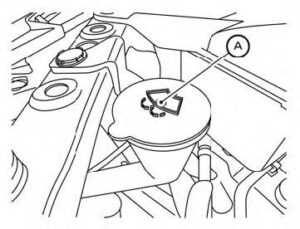
WINDSHIELD-WASHER FLUID RESERVOIR
Fill the windshield washer fluid reservoir periodically. Add windshield-washer fluid when the “Low Washer Fluid” warning appears in the vehicle information display. To check the fluid level with the dip tube, use your finger to plug the center hole OA of the cap/tube assembly, then remove it from the reservoir. If there is no fluid in the dip tube, add fluid. To fill the windshield-washer fluid reservoir, lift the cap off the reservoir and pour the windshield-washer fluid into the reservoir opening. Add a washer solvent to the washer for better cleaning. In the winter season, add a windshield washer antifreeze. Follow the manufacturer’s instructions for the mixture ratio. Refill the reservoir more frequently when driving conditions require an increased amount of windshield washer fluid. Recommended fluid is Genuine NISSAN Windshield Washer Concentrate Cleaner & Antifreeze or equivalent.
WARNING
Antifreeze is poisonous and should be stored carefully in marked containers out of the reach of children.
CAUTION
Do not substitute engine antifreeze coolant for windshield washer fluid. This may result in damage to the paint. Do not fill the windshield washer fluid reservoir with washer fluid concentrates at full strength. Some methyl alcohol-based washer fluid concentrates may permanently stain the grille if spilled while filling the windshield washer fluid reservoir Pre-mix washer fluid concentrates with water to the manufacturer’s recommended levels before pouring the fluid into the windshield washer fluid reservoir. Do not use the windshield washer fluid reservoir to mix the washer fluid concentrate and water.
| Caution symbols for battery | WARNING | ||
| O1 | No smoking, No exposed flames, No Sparks | Do not expose the battery to electrical sparks, flames, or smoking. Hydrogen gas generated by the battery is explosive. Explosive gases can cause blindness or injury. | |
| O2 | Shield eyes | Handle the battery cautiously. Always wear eye protection glasses to protect against explosion or battery acid. | |
| O3 | Keep away from children | Never allow children to handle the battery. Keep the battery out of the reach of children. | |
|
O4 |
Battery acid | Do not allow battery fluid to contact your skin, eyes, fabrics, or painted surfaces. Sulfuric acid can cause blindness or severe burns. After touching a battery or battery cap, do not touch or rub your eyes. Thoroughly wash your hands. If the acid contacts your eyes, skin, or clothing, immediately flush with water for at least 15 minutes and seek medical attention. Battery fluid is acid. If the battery fluid gets into your eyes or onto your skin, it could cause loss of your eyesight or burns. | |
| O5 | Note operating instructions | Before handling the battery, read this instruction carefully to ensure correct and safe handling. | |
| O6 | Explosive gas | Hydrogen gas generated by battery fluid is explosive. Explosive gases can cause blindness or injury. | |
- If the battery is labeled “do not open” it is maintenance and battery fluid should not be checked. It is recommended that you visit a NISSAN dealer or a qualified specialist workshop to confirm the battery’s performance. Keep the battery surface clean and dry. Clean the battery with a solution of baking soda and water. Make certain the terminal connections are clean and securely tightened. If the vehicle is not to be used for 30 days or longer, disconnect the negative (-) battery terminal cable to prevent discharge.
NOTE:
Care should be taken to avoid situations that can lead to potential battery discharge and potential no-start conditions such as:
- Installation or extended use of electronic accessories that consume battery power when the engine is not running (Phone chargers, GPS, DVD players, etc.)
- The vehicle is not driven regularly and/or only driven short distances.
- In these cases, the battery may need to be charged to maintain battery health.
WARNING
Do not expose the battery to flames, an electrical spark, or a cigarette. Hydrogen gas generated by the battery is explosive. Explosive gases can cause blindness or injury. Do not allow battery fluid to contact your skin, eyes, fabrics, or painted surfaces. Sulfuric acid can cause blindness or injury. After touching a battery or battery cap, do not touch or rub your eyes. Thoroughly wash your hands. If the acid contacts your eyes, skin, or clothing, immediately flush with water for at least 15 minutes and seek medical attention. When working on or near a battery, always wear suitable eye protection and remove all jewelry. Battery posts, terminals, and related accessories contain lead and lead compounds. Wash hands after handling. Keep the battery out of the reach of children. Do not tip the battery.

NOTE:
Do not try to open the top of the battery. This battery is not equipped with removable vent caps.
JUMP STARTING
If the engine does not start by jump starting, the battery may have to be replaced. It is recommended that you visit a NISSAN dealer for this service.
FAQ
Regular maintenance precautions for the Altima include following the recommended service schedule, using genuine Nissan parts, and having repairs and services performed by qualified technicians.
The recommended oil change interval for the Altima may vary depending on factors like engine type and driving conditions. Check the owner’s manual for specific guidelines.
Basic maintenance tasks can be performed by owners, but it’s essential to follow the instructions in the owner’s manual and use the correct tools and materials.
Tire pressure should be checked regularly, typically once a month, and adjusted to the recommended levels as specified in the owner’s manual or on the driver’s door jamb.
Regular brake inspections and maintenance are essential to ensure optimal braking performance. Any unusual noises or sensations should be promptly addressed.
While some aftermarket parts and accessories are compatible with the Altima, it’s advisable to use genuine Nissan parts to maintain performance and warranty coverage.
Regular washing, waxing, and protection from environmental factors can help keep the Altima’s exterior in excellent condition.
Many modern vehicles, including the Altima, often come equipped with a maintenance reminder system that alerts you when it’s time for scheduled service.
Battery health can be checked using a battery tester, which can be done by yourself or by a professional technician during routine maintenance.
The lifespan of a car battery can vary based on factors like climate and usage, but it often ranges from 3 to 5 years.
Jump-starting the battery should be done following proper procedures outlined in the owner’s manual, including connecting cables in the correct order to avoid damage to the vehicle’s electrical system.
Yes, a battery charger or maintainer can help extend the life of the battery by keeping it charged during long periods of inactivity.
The Altima often has a battery warning light on the instrument panel that illuminates when there is a low battery voltage or charging system issue.
Disconnecting the battery or using a battery maintainer can help preserve the battery during extended periods of inactivity.
Battery replacement can be done by yourself, but it’s essential to follow proper safety procedures and use the correct battery type and specifications.
Useful Link
View Full User Guide: Nissan ALTIMA 2023 User Guide
Download Manuals: https://www.nissanusa.com/owners/ownership/manuals-guides.html
2023 Nissan Altima Specs, Price, Features, and Mileage (Brochure)

